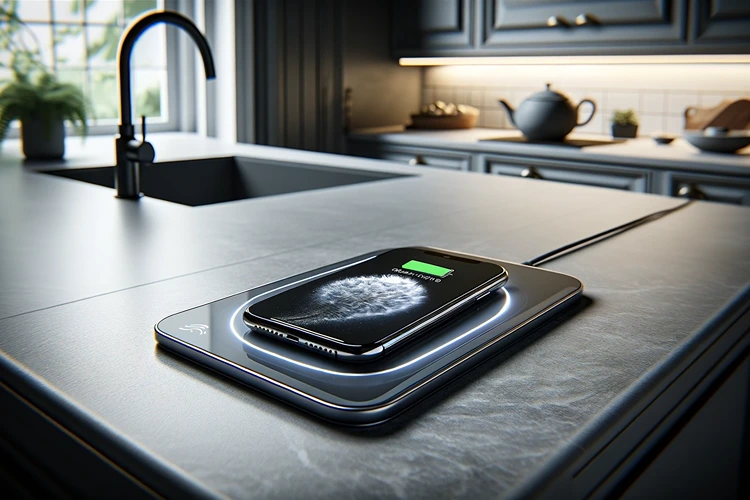Building Homes with Built-In Wireless Charging Stations

Imagine living in a home where every surface can power up your devices, wirelessly. The concept of building homes with built-in wireless charging stations is not just futuristic; it’s happening now.
This innovation brings convenience and an aesthetic, clutter-free lifestyle into our living spaces. But what does it involve, and how can you integrate this technology into your home? Let’s explore the transformative journey of integrating wireless charging into home construction and design.
What is a Wireless Charging Technology
Wireless charging, also known as inductive charging, uses electromagnetic fields to transfer power from a charging station to a device without cords. This technology is not just for smartphones. It extends to tablets, laptops, and even kitchen appliances.
The concept is simple: place your device on a surface with a built-in charging pad, and it starts charging. No plugs, no cables, just pure convenience.
Helpful Hint:
When planning to integrate wireless charging into your home, consider areas of high device usage. Kitchens, living rooms, and bedrooms are ideal locations for built-in charging stations.
The Benefits of Integrating Wireless Charging in Homes

Integrating wireless charging stations into homes goes beyond convenience. It represents a step towards smart living, offering several benefits:
- Clutter-Free Surfaces: Eliminate the tangle of charging cables and adapters from countertops and bedside tables.
- Enhanced Home Design: Wireless charging can be seamlessly integrated into furniture and surfaces, maintaining the aesthetic appeal of your home.
- Future-Proofing: As more devices adopt wireless charging, homes equipped with this technology will stay current with technological advancements.
How to Implement Wireless Charging in Home Construction
Implementing built-in wireless charging requires careful planning during the design and construction phases. It involves choosing the right technology, determining the optimal placement, and ensuring compatibility with a wide range of devices. Here are the steps to get started:
- Select the Right Wireless Charging Standard: Qi is the most widely used standard, supported by most smartphones and devices.
- Plan for Electrical Requirements: Ensure your home’s electrical system can support the added load of multiple charging stations.
- Integrate Charging Stations into Surfaces: Work with your architect or designer to incorporate charging pads into furniture, countertops, and nightstands.
Stats:
According to a recent survey, over 60% of homeowners expressed interest in smart home technologies, with wireless charging being one of the top desired features.
Design Considerations for Wireless Charging in Homes
Design plays a crucial role in integrating wireless charging into homes. It’s not just about functionality; aesthetics matter too. Consider the following when designing your space:
- Material Compatibility: Most wireless chargers work through wood and plastic but may struggle with metal surfaces.
- Location and Accessibility: Place charging stations in areas where you’re likely to use devices, ensuring they are easily accessible.
- Design Integration: Wireless charging stations should blend with your home’s design. Custom solutions can hide charging pads beneath surface materials for a seamless look.
Specific Applications of Wireless Charging in Home Design

The versatility of wireless charging technology allows for its application in various aspects of home design. Let’s explore some innovative ways to incorporate this feature into your living space:
- Kitchen Countertops: Imagine preparing your meals while your smartphone charges directly from your kitchen counter. Incorporating charging spots into kitchen islands or countertops adds convenience for busy homeowners.
- Bedside Tables: A bedside table with a built-in charging pad means you can charge your phone or tablet overnight without fumbling for cables in the dark.
- Home Offices: Enhance productivity by integrating wireless charging into desks or office tables, keeping devices powered up during work sessions.
- Entertainment Centers: Charging stations in entertainment units allow for easy charging of remote controls, game controllers, and other devices, ensuring they’re always ready for use.
Challenges and Considerations
While the integration of wireless charging into homes offers numerous benefits, there are challenges to consider:
- Cost: The initial setup cost can be higher than traditional charging methods due to the need for specialized equipment and installation.
- Technology Compatibility: Ensuring that the installed charging stations are compatible with a wide range of devices and adhere to universal standards like Qi can be a hurdle.
- Efficiency: Wireless charging is not as efficient as direct charging, and some energy is lost in the process, which could lead to slightly higher electricity bills.
Helpful Hint:
To mitigate the efficiency concern, look for the latest generation of wireless charging technology that promises higher energy transfer rates and lower loss.
Maintenance and Upkeep
Maintaining built-in wireless charging stations is relatively straightforward, but there are tips to ensure longevity and performance:
- Regular Cleaning: Keep charging surfaces clean and free of debris to ensure optimal charging efficiency.
- Software Updates: For smart charging systems, regular software updates can enhance compatibility and performance.
- Technical Checkups: Periodic inspections by a professional can help identify and rectify any electrical issues before they become problematic.
Looking Towards the Future
The future of home design includes more than just built-in wireless charging stations. It leans towards fully integrated smart homes where almost every aspect is controlled and monitored for efficiency, comfort, and convenience. Wireless charging is a step towards this future, promising a home environment that is more connected, functional, and tailored to our digital lives.
Stats:
Future projections indicate that by 2025, more than 75% of households will have at least one device with wireless charging capabilities, highlighting the growing importance of this technology in home design.
FAQs
Bottom Line
The integration of built-in wireless charging stations into home design is more than a luxury; it’s a forward-thinking approach to modern living.
As we move towards a world where convenience and technology go hand in hand, the inclusion of such features in homes becomes not just desirable, but almost essential.
By embracing wireless charging, homeowners can enjoy a clutter-free, aesthetically pleasing environment that caters to the digital age. From kitchen countertops to bedside tables, the possibilities are endless, turning ordinary spaces into power hubs for our everyday devices.
Despite the challenges, such as initial costs and technology compatibility, the benefits of wireless charging in homes outweigh the drawbacks. With careful planning, consideration, and a keen eye for design, it’s possible to create spaces that not only meet our technological needs but also enhance our living experience.
As technology continues to evolve, the home of the future will likely see even more integration of wireless charging, making cables and cords a thing of the past.
The key to successful implementation lies in understanding the technology, recognizing its potential impact on design and lifestyle, and staying ahead of the curve in home innovation.
Additional Resources:
- Wireless Power Consortium (WPC): Visit www.wirelesspowerconsortium.com for the latest standards and advancements in Qi wireless charging technology. The WPC is a group of leading companies that develop and promote Qi, the global standard for wireless charging.
- Smart Home Technology Resources: For insights into the latest smart home technologies and how they integrate with wireless charging, check out www.smarthome.com. This website offers a wide range of products and educational content to make your home smarter and more efficient.


